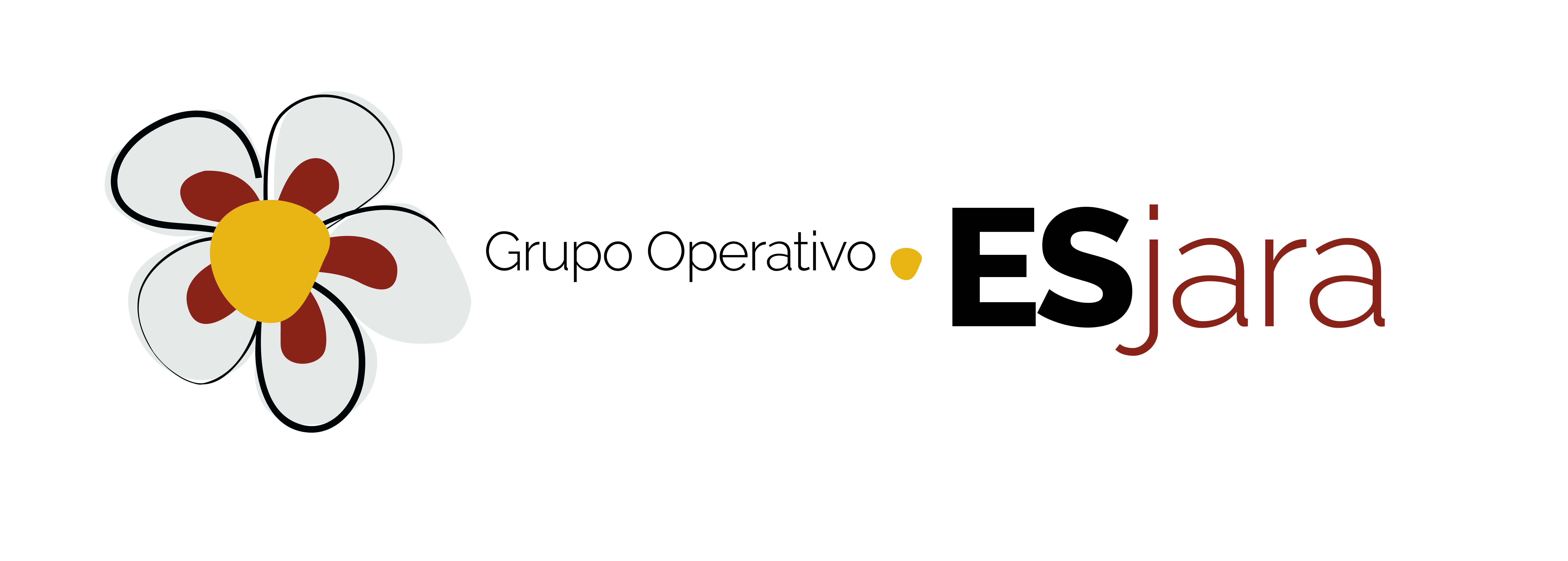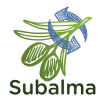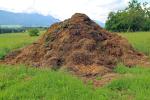
ESJARA Operational Group: Rockrose essential oil for the development of the bioeconomy in rural areas
- Type Operational group
- Status Filled
- Execution 2023 -2025
- Assigned Budget 599.820,49 €
- Scope Supraautonómico
- Autonomous community Andalucía; Castilla y León; Castilla - La Mancha; Extremadura
- Main source of financing CAP 2014-2020
- Project website https://goesjara.es/
ESJARA promotes the development of the potential for obtaining rockrose derivatives and, in particular, essential oils through the active management of Cistus ladanifer and Cistus laurifolius thickets, extending the activity to new areas currently abandoned and modernizing its collection to generate economic returns for its owners and contribute to the fight against climate change through sustainable forest management and fire prevention.
Characterization of essential oils and hydrolates
In order to obtain new applications for essential oils and hydrolates derived from rockrose and steppe, various analyses have been conducted to measure biological activity against phytopathogenic fungi and weeds. The differences observed in the chemical composition studies are reflected in the activity assays, with differences in activity observed depending on the location of origin, the time of year of harvest, and the extraction method used. Antifungal activity against various pathogenic fungi that affect citrus fruits after harvest has been determined. In general, what has been observed is that the most active compounds against these fungi are rockrose essential oils, primarily against Phytophthora citrophthora, which causes a type of brown rot.
Anti-germination activity against weeds has also been determined, with hydrolates being more active in this case, especially the one from El Ordial (Guadalajara) obtained by steam distillation from crushed material.
Different methods of essential oil extraction
We compared the composition of essential oils obtained from three different distillation methods: steam distillation (SD), hydrodistillation (HD), and solvent-free microwave distillation (SFME). To do this, we collected biomass from two Cistus species: Cistus ladanifer in El Ordial (Guadalajara) and Cistus laurifolius (steppe) in Lubia (Soria). Sampling was carried out over a 10-month period, from April to November, with samples collected every two months. The percentage of compounds identified in each oil sample varies for the same location depending on the collection date and the distillation method chosen, although the differences are primarily quantitative, not qualitative. Hydrodistillation or microwave-assisted extraction yields an essential oil with a higher percentage of oxygenated compounds in both species. Steam extraction is an official and widely used method, while newer techniques (solventless microwave extraction) are considered promising due to their shorter extraction time, low energy consumption, low solvent use, and lower carbon dioxide emissions. Therefore, whether the extraction method influences the composition and aromatic profile of rockrose or steppe essential oil will be another parameter to consider depending on the final destination industry for these oils.
Board manufacturing and formaldehyde measurement
We evaluated the characteristics of rockrose particles after extraction and their effect when incorporated into the production of single-ply boards, mixed with Scots pine particles. The particle size distribution, bulk and basic density, pH, and buffer capacity of Cistus ladanifer were determined. Boards measuring 383x383 mm, 10 mm thick, and with a density of 620 kg/m3 were manufactured with proportions of 15%, 30%, 45%, and 100% rockrose particles, three replicates per board, plus a blank consisting of 100% pine particles.
The board evaluation included mechanical properties: flexural strength (MOE), breaking strength (MOR), and perpendicular tensile strength; as well as physical properties: density, swelling, water absorption, humidity, and quantification of formaldehyde emissions using the flask method. The results showed that mixing pine and rockrose particles produced boards with good perpendicular tensile properties, although this was not the case with MOE and MOR, probably due to the particle size distribution of the particles used. Formaldehyde emission was low in all the boards, suggesting that rockrose could be used in the form of flour as a formaldehyde trap.
Mechanized harvesting: Efficiency and differentiated uses for sticky rose and steppe rockrose
The demonstration work on mechanized harvesting was carried out satisfactorily in the low-slope areas of the pilot areas defined in the proposal, except for the rockrose-steppe clearing in Guadalajara, which was transferred to the Lubia (Soria) CEDER for environmental reasons. The clearing results with the López Garrido TBA2300 brushcutter-shredder were more favourable than with the Biobaler WB55 brushcutter-baler, collecting 3 times more biomass per hectare and 2.6 times more biomass per production hour, which translates into lower costs per tonne and per production hour, with figures around €45/fresh tonne collected with the brushcutter-shredder and net costs of €82/production hour. Young stands of sticky rockrose (Cistus ladanifer), aged 4-8 years, are the most suitable for use to obtain essential oil, raising the cutting height of the brushcutter to collect the apical part of the vegetation. Older stands and those of rockrose (Cistus laurifolius) are best used for biofuels, working with the machine on the ground to obtain the greatest possible amount of biomass.
Remote sensing for improving the sustainable use of rockrose
The GO Esjara project has taken a major step forward in the identification and mapping of rockrose forests thanks to remote sensing technologies. Using Sentinel-2 satellite images and LIDAR data from the National Park Service (PNOA), the team has developed a detailed map of rockrose distribution in the study regions, significantly improving the accuracy of previous mapping. The study has made it possible to estimate and map the available biomass in rockrose forests, which is key to their sustainable use. By applying models based on LIDAR data, it has been possible to quantify the amount of sticky rockrose (Cistus ladanifer) and steppe rockrose (Cistus laurifolius) biomass in each area, contributing to the efficient management of these resources. A notable example is the model applied to the Sierra Guadalajara region, where the total biomass of both species was calculated. Although the methodology has shown significant progress, the study also revealed the need to continue improving the integration of satellite and mapping data, especially in regions with phenological variability. These results lay the foundation for more efficient and sustainable management of rockroses, promoting their use in the rural bioeconomy.
Predicting rockrose essential oil production using satellite images
One of the major questions we asked ourselves when starting this project was whether rockrose had a unique "fingerprint" in satellite images, like a plant ID, that would allow us to predict its essential oil production. Over the years, we have made progress in the use of remote sensing technologies to estimate essential oil production of rockrose (Cistus ladanifer and Cistus laurifolius). Using Sentinel-2 satellite images and machine learning models, different pilot areas have been analyzed to determine the relationship between vegetation status and oil yield at different times of the year. Oil yields in the field were obtained by harvesting rockrose in different seasons (spring, summer, autumn, and winter), followed by a steam distillation process, where the amount of essential oil extracted was measured in relation to the dry biomass processed. Studies have revealed that the highest essential oil yields are obtained in spring and autumn, although there are cases where summer also shows good results. This breakthrough paves the way for the generation of dynamic oil yield maps that could optimize harvest planning, maximizing essential oil extraction efficiently and sustainably.
Economical itineraries
The analysis of rockrose economic pathways identifies four harvesting methods: manual harvesting with a sickle, semi-manual harvesting with a brush cutter, mechanized harvesting with a baler, and mechanized harvesting with a crusher.
Each has advantages and limitations in terms of yield, operating costs, and the quality of the essential oil obtained: manual harvesting is the most expensive and produces the lowest yield, while mechanized harvesting with a crusher maximizes efficiency but prevents the production of labdanum.
As for distillation, this can be carried out in a factory or on the farm, with associated costs of €20-40/kg and €50/kg, respectively.
Itineraries for the Use of Rockrose.
- Itinerary 1: Manual Harvest + Distillation in Factory or in Mountain.
- Itinerary 2: Mechanized Harvesting with Packing House + Distillation in Factory.
- Itinerary 3: Mechanized Harvesting with Crusher + Distillation in the field or in the factory.
Location of new distillation plants
The objectives are as follows:
- Evaluate the territorial viability of installing new distillation plants in two different areas, considering resource availability and market demand.
- Identify optimal locations for these plants, using information generated in previous activities and relevant geospatial criteria.
- Formulate recommendations to ensure the effective implementation of the new facilities, optimizing their operation, sustainability, and profitability.
- Regarding the location of new plants, five provinces were analyzed based on the distribution of rockroses, biomass, potential for mechanization, and market demand. Guadalajara and Badajoz were ultimately selected as the most suitable, while Huelva, Zamora, and Burgos were ruled out due to their low suitability for industrial use. The use of biomass and solar energy is recommended as sustainable energy sources, and the feasibility of innovative technologies such as microwaves or CO2 for distillation is being evaluated.
Composition of rockrose oil
- The chemical composition of Cistus ladanifer essential oil can be very complex, with up to 300 different compounds detected in some cases, of which only a small group of terpenes are present in significant proportions. The properties of an essential oil, therefore, are not usually determined by a specific compound; rather, it is the proportion of all of them that determines the final quality of the product.
- For other types of essential oils including those from rockrose, variations have been described. In the Esjara project we analysed the essential oil composition of two varieties of Cistus, Cistus ladanifer (sticky rockrose) and Cistus laurifolius (steppe rockrose) in different locations and in different seasons.
- The qualitative composition of rockrose (Cistus ladanifer) oils basically shows no differences by location or season, but there are quantitative differences. The most representative group are the hydrocarbon monoterpenes, with α-pinene being the majority compound in all oils, regardless of location and sampling season. Regarding oxygenated monoterpenes, the Aliste summer sample has the highest percentage of bornyl acetate (7.36%), along with the Huelva samples collected in summer (7.32%) and autumn (6.63%). This pattern is repeated with the hydrocarbon sesquiterpenes.
Viewfinder
As part of the project, a viewer was developed that allows for identifying the area of rockrose, as well as estimating available biomass, the potential for mechanization, and the risk of fire. This was developed in collaboration with project partners representing the harvesting and distillation industry to best serve potential users. As a result of the aforementioned developments, the following responsive cartographic product was created for different devices, with the aim of assisting the various stakeholders involved in the sector, particularly from the perspective of pre-operational assessments for rockrose operations.
The address to access it is the following: https://goesjara.es/visor/
ResinApp
This tool has a web management section for the company, where the specific harvest or tillage area must first be configured and linked to the desired field user, which will also be created from the web platform. Once the farm has been defined and characterized, the linked field user accesses the app using their mobile device and the associated app, after downloading it from the website, with the credentials pre-established by the company. It includes the ability to edit weighings and geometries in the app, prior to synchronizing them with the website, as well as the ability to incorporate weighings or areas directly from the website by the company, automatically adding tons weighed by area and harvest and tillage area, as well as other smaller implementations. This also includes enabling history, calendar, and statistics.
- Identification of the potential of rockroses for the production of essential oils in 5 pilot areas
- Develop innovative solutions for bringing new areas into production through resource management using mechanized resources.
- Develop new applications for rockrose essential oils and by-products that provide new uses, greater added value, and provide circularity to the value chain
- Generation of a business model focused on end users that incorporates innovation and allows the development of the rockrose harvesting activity in new areas of the national territory
- Cooperation, transfer and dissemination of opportunities to enhance the value of rural populations
- Precision mapping of biomass/exudates/essential oils from rockroses and a tool for predicting optimal harvest times
- Optimization of the logistics chain based on technological solutions for the extraction of essential oils and development of a digital tool for harvest management, logistics, and traceability of raw materials, ESjaraQR, to reduce costs.
- Obtaining and characterizing products from waste
- Owners' associations and rockrose utilization plans in the regions
- Active cooperation and project management as knowledge transfer tools
- Name of the coordinator/entity: Foundation for the Center for Services and Promotion of Forestry and its Industry of Castilla y León (CESEFOR)
- Coordinator/entity email: raquel.puntero@cesefor.com
- Junta de Castilla y León
- Dirección General de Medio Natural y Biodiversidad de Castilla-La Mancha
- Fundación Centro de servicios y Promoción Forestal y de su Industria de Castilla y León (CESEFOR)
- Centro de Investigaciones Energéticas Medioambientales y Tecnológicas (CIEMAT)
- Agresta Sociedad Cooperativa
- Biolandes Andalucía S.A.
- El Jarpil S.L.
- Federación de las Asociaciones Forestales de Castilla y León (FAFCYLE)
- Rooteco Agriculture S.L.
- Asociación Forestal de Zamora
- Asociación Forestal de Burgos
- Federación Española de la Dehesa







